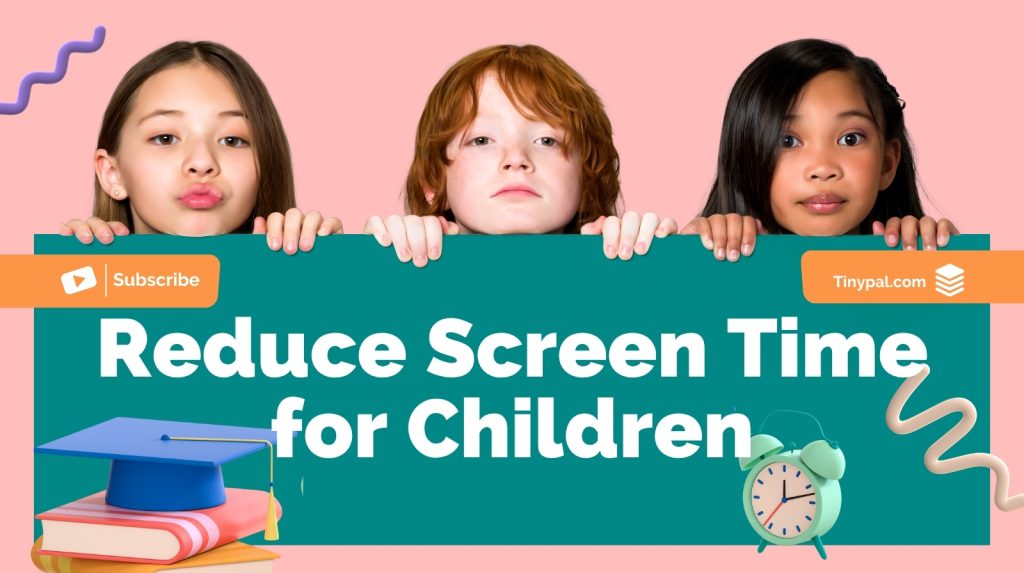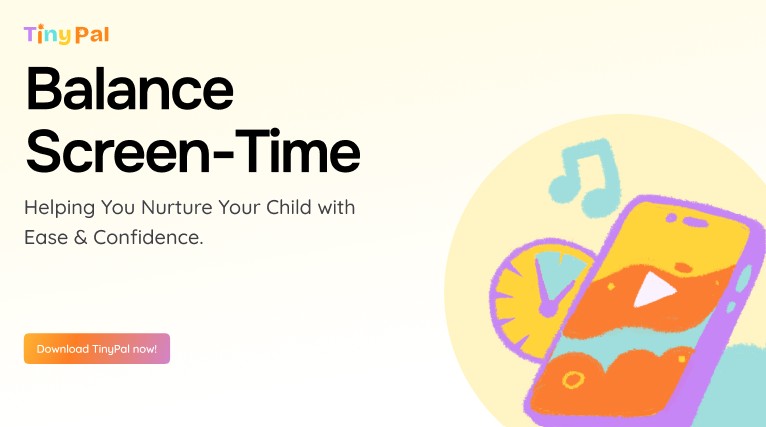12 Proven Tips to Reduce Screen Time for Children: A Parent’s Complete Guide
Because balanced screen time means balanced childhood.
The Story Every Modern Parent Knows Too Well
It starts with a simple “just five more minutes.”
Your child’s eyes are glued to the glowing screen — cartoons, games, YouTube, TikTok. You try to negotiate, but that five minutes turns into an hour. Before you know it, dinner’s cold, tempers flare, and guilt creeps in.
You’re not alone.
Parents across the world are battling the same invisible addiction — screens. But the solution doesn’t lie in punishment or banning devices; it lies in balanced digital parenting — something TinyPal helps you master effortlessly.
TinyPal isn’t a tracker; it’s your parenting companion that guides, educates, and helps you build mindful habits — both for you and your child.
In this guide, we’ll teach you 12 practical, psychology-backed tips to reduce screen time for children, supported by insights from child development research and modern parenting frameworks.

Table of Contents
1. Start With Awareness, Not Control
Before reducing screen time, understand how much time your child actually spends — and what type of content they consume.
Use TinyPal’s behavior tracking insights to identify patterns: Are they watching learning videos or mindless scrolling? Awareness is the first step toward change.
🧩 Parent Tip:
Instead of sudden bans, discuss screen use openly. Children respond better to empathy than authority.
2. Model Healthy Digital Behavior
Children mirror what they see. If parents constantly check phones or watch TV during meals, kids learn the same.
TinyPal’s micro-habits module teaches parents how to build tech-free routines — like “no screens during meals” or “family walks before bedtime.”
💡 Key Insight:
Kids copy actions, not advice. Be the model of balance.
3. Create Tech-Free Zones at Home
Designate areas where screens are off-limits — bedrooms, dining areas, or study corners.
When kids associate spaces with specific behaviors (e.g., “bedroom = rest”), they subconsciously reduce the urge to use devices there.
✨ Pro Tip: TinyPal’s environment tracker helps you identify triggers and re-establish boundaries at home.
4. Replace, Don’t Restrict
Boredom drives screen addiction.
Instead of saying “no screens,” say “let’s paint,” or “let’s cook together.” Offer alternative activities that engage curiosity and creativity.
🏕️ Try This:
- Family art night
- DIY science experiments
- Reading challenges
TinyPal provides curated lists of offline activities tailored to your child’s age and interests.
5. Follow the 20-20-20 Rule
Every 20 minutes of screen use, take a 20-second break to look at something 20 feet away.
This reduces eye strain and builds awareness around time spent on screens.
TinyPal helps parents integrate such micro-reminders into daily routines.

6. Set Clear Screen Time Boundaries
Children thrive on structure.
Set consistent limits (e.g., 1 hour per day) using clear expectations — not threats. Use positive reinforcement (“You did great keeping it under an hour today!”) instead of punishment.
🕒 TinyPal Insight:
Our digital wellness reminders help parents enforce limits without conflict.
7. Make Screen Time Purposeful
Not all screen time is bad. Educational shows, coding games, and documentaries can nurture learning.
The key is intentional usage — know the “why” behind every click.
🧠 TinyPal Tip:
Our app helps you differentiate between passive watching and active learning — so you encourage the right kind of digital growth.
8. Prioritize Outdoor Play
According to the American Academy of Pediatrics, outdoor activity boosts cognitive function, improves sleep, and naturally reduces screen time.
Encourage your child to play outside daily, even for 30 minutes.
TinyPal helps track outdoor engagement, motivating children through rewards and achievements.
9. Use Technology Together
Shared screen time (like watching documentaries together) strengthens family bonds.
When parents participate, they can guide discussions, explain ideas, and limit exposure to negative content.
🎬 TinyPal Suggestion:
Try co-viewing educational programs, then discuss what you learned together.

10. Encourage Mindful Media Choices
Teach your child to evaluate what they watch — ask:
- “Does this help me learn something?”
- “Does it make me feel good or bad?”
This builds self-awareness and emotional intelligence.
TinyPal integrates emotional feedback prompts that train kids to self-reflect after each session.
11. Maintain Sleep Hygiene
Screens before bedtime disrupt melatonin production and sleep cycles.
Implement a ‘no screens 1 hour before bed’ rule. Replace with reading, journaling, or bedtime talks.
🌙 TinyPal Reminder:
Night mode notifications encourage wind-down routines automatically.
12. Build a Family Digital Plan
Create a shared digital agreement where everyone — including parents — commits to balanced usage.
TinyPal’s templates make this effortless.
🖋️ Sample rule:
“No screens during meals, family time, or after 9 PM.”
When kids feel included in the rule-making, they own the process.
How TinyPal Helps You Reduce Screen Time
TinyPal isn’t just another app — it’s your AI-powered parenting companion that helps you:
- Identify screen-time patterns
- Build balanced family habits
- Encourage emotional growth
- Replace digital guilt with mindful parenting
It’s not about control — it’s about connection, awareness, and evolution.
🔗 Discover TinyPal — The Best Parenting App for Modern Families

Key Takeaways for Parents
| Strategy | Description | TinyPal Support |
|---|---|---|
| Awareness | Understand current screen patterns | Behavior analysis tools |
| Boundaries | Set healthy screen limits | Customizable reminders |
| Alternatives | Replace with offline learning | Age-based activity suggestions |
| Emotional Insight | Teach self-reflection | Mood tracking system |
FAQs — Reducing Screen Time for Children
1. What is a healthy screen time limit for kids?
Experts recommend 1–2 hours per day of recreational screen time, depending on age and content.
2. How do I get my child off screens without conflict?
Involve them in creating the rules, and offer engaging alternatives. TinyPal’s family habit tracker helps maintain consistency.
3. Is educational screen time okay?
Yes, as long as it’s interactive and age-appropriate. Focus on quality, not just quantity.
4. My child throws tantrums when I turn off screens. What should I do?
Transition gradually and explain the reason behind the rule. Reward cooperation.
5. How does TinyPal support balanced screen habits?
It provides behavioral insights, reminders, and learning-based digital activities for holistic growth.
Conclusion
Screen time is not the enemy — imbalance is.
By combining structure, mindfulness, and modern parenting tools like TinyPal, families can transform screen time into growth time.
Start today — and watch your child rediscover the world beyond the screen.

